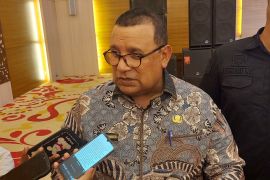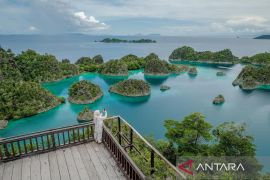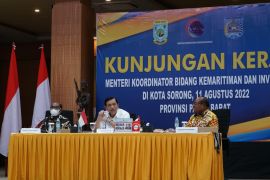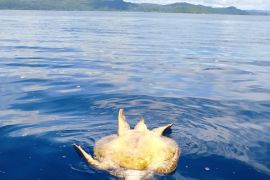The islands of Waigeo, Misol, Kofiau, Batanta, and Salawati are some of the more than 1500 islands in Raja Ampat that are rich in biodiversity of birds.Jakarta (ANTARA News) - Besides known as an object of beautiful marine tourism, the Raja Ampat Islands District in the Indonesian province of West Papua also holds the potential wealth of outstanding land with more than 300 species of birds in its forests.
Having more than 1500 large and small islands with many of them under protecting status, Raja Ampat is famous for its unique biodiversity of both flora and fauna.
Raja Ampat, also dubbed as the "last paradise on earth," is home to a variety of unique plants and animals of amphibians, reptiles, mammals, and hundreds of bird species such as the famous birds of paradise and the flightless cassowary.
The islands of Waigeo, Misol, Kofiau, Batanta, and Salawati are some of the more than 1500 islands in Raja Ampat that are rich in biodiversity of birds.
Raja Ampat District Head Abdul Faris Umlati has stated that the Flora and Fauna International (FFI) has recorded 173 bird species
in Waigeo island, 141 species in Misol islands, and more than 50 species in Kofian island.
Thus, in these three islands of Raja Ampat, more than 300 birds species have been recorded, of which, 94 including 11 endemic ones are protected.
Based on a research conducted in West Waigeo Nature Reserve, there are 27 mammal species including including bandikut (Echymipera kalubu), spotted cuscus (Phalanger maculatus), striped opossum (Dactylopsila trivirgata), bats and the tree rats.
The survey in South Misool Nature Reserve recorded 159 bird species including 4 birds of paradise and 5 bat species, and numerous protected rare birds.
There are yellow-crested white cockatoo bird (Cacatua galerita), forest kingfisher (Halcyon macleayii), julang Irian (Aceros plicatus), king parrots (Probosciger aterrimus), parrots (Eclectus roratus), red-black-headed parrot (Eclectus roratus lory), Mambruk Viktoria (Goura victoria), cassowaries, Paradisaea sp., and maleo (maleo Magrocephalus).
Once the visitors arrive in the forest of Raja Ampat, they will be greeted by these lovely birds with their lovely songs found and heard nowhere else around the world.
Also, delicately tinted wild flowers perfuming the air, along with the lofty trees of the forest with their rich foliage of living green, are found around for visitors to enjoy.
In just a moment, the lofty, trees, the buds, the flowers, and its surrounding beauty can speak to the hearts of visitors and invite them to become acquainted with Him who made them all.
There, the visitors will be amazed by the trees, the buds, the flowers, and the birds of the air as they warbled their carols of praise, unencumbered with thought of care.
Further, the hospitality of the local residents will cause the tourists visiting Raja Ampat to be amazed and curious to explore the extent to which the area is rich in both natural and marine beauty.
The abundance of undersea and land biological diversity is so stunning and has also made Raja Ampat archipelago a paradise for eco-tourism activities.
With average sea temperatures from 22 to -30 degree Celsius, the waters of Raja Ampat has approximately 603 hard coral species, representing 75 percent of total coral reefs in the world.
Based on various studies by the world natural conservation agencies like Conservation International and Nature Conservancy, Raja Ampat waters are estimated to have 1397 fish species. It is not mistaken that the waters of Raja Ampat is also called "Capital for Fish in the World".
Besides fish species in the marine waters of Raja Ampat archipelago, there are also 60 crayfish, 699 types of soft animals (species of mollusks) consisting 530 snails (Gastropoda), 159 shells (bivalva), 2 Scaphopoda, 5 squid ( Cephalopoda) and 3 Chiton.
Known as the most bio-diverse marine habitat on earth, the Indonesian archipelago of Raja Ampat is an ideal destination for both local and foreign tourists to relax and unwind.
The visitors to Raja Ampat will have the opportunity to witness a multitude of marine habitats and coral reefs in one glance without having to swim a stroke.
Raja Ampat comprises four large islands and hundreds of dots and specks off the fragmented western corner of the land of Papua, the worlds second-largest island.
Most visitors arrive in Raja Ampat through Sorong, a city on the far west coast of Papua, which has an airport, army barracks, and a karaoke bar called Happy Puppy.
In less than two hours from Sorong, the visitors can reach Raja Ampat, where they can indulge in activities, such as swimming, diving, and snorkeling, or just relax.
Reaching Raja Ampat has now become easier as the Bahari Express fast boat, a public transportation service, is offering rides to foreign tourists from Sorong city to visit the tourist attractions there.
In Raja Ampat, the tourists can enjoy not only the beautiful marine biodiversity but also the scenic beaches and gain local insights into the history of Raja Ampat.
In terms of historic relevance, in the 15th century, the Raja Ampat Archipelago was part of the reign of Tidore Sultanate, a great kingdom centered in Maluku Islands.
To run its government, the Sultanate of Tidore appointed four local kings to rule the islands of Waigeo, Batanta, Salawati, and Misool, which are the fourth-largest until this day.(*)
Reporter: Otniel Tamindael
Editor: Heru Purwanto
Copyright © ANTARA 2016











